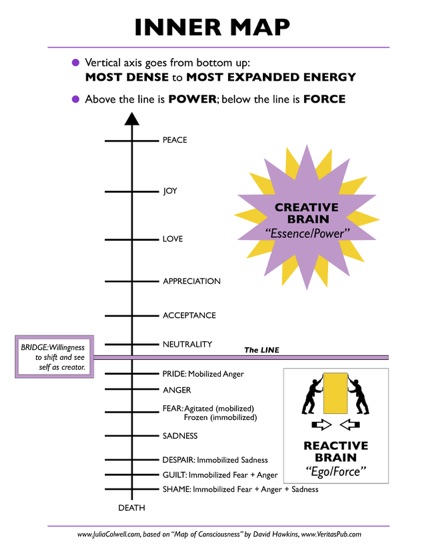Kathlyn (Katie) Hendricks, PhD, BC-DMT, and Julia (Julie) Colwell, PhD, are pioneers in the field of human consciousness, conscious leadership and human potential. Nancy Kepner, co-founder of Crafted Leadership, LLC, sat down with Katie and Julie to get their perspective on a range of issues. Crafted Leadership’s mission is to spread conscious leadership throughout the global workplace, using Julie and Katie’s work as the foundation.
Katie: If we think of nature as a person, what does nature want? We don’t ask what nature wants. The whole possibility of moving into riding waves of co-creativity – I know that’s possible because I’ve been living in those co-creative waves for several years now. [Gay and I] dreamed up these waves a long time ago and wrote about them in The Conscious Heart.
Maybe it’s possible to move through awakening and then going back to sleep, and then being awake, and sleeping, and starting to live in essence, and then essence becomes more permanent. Then, you ride waves of creativity, and then continue noticing and riding the next wave of creativity. That flow is totally possible.
Nancy: Brilliant. I love that you mapped it out without really knowing.
Katie: We didn’t.
Nancy: We’re all making it up as we go.
Katie: Exactly.
Nancy: I want to pick up on that because that’s what my observation has been about business in America. I’ve heard you say, Katie, that we have a bias against feelings, and a bias toward hierarchy, and rational, and division of labor, a bias against actual collaboration. Julie, you talk about hierarchy and how once we are in threat brain we automatically orient towards hierarchy. That shows up in business all the time. It has been the dominant model.
Let’s say you were sitting around with the CEO’s of the largest companies and they asked, “Julie and Katie, what the heck do we do with business in America? It’s not really working, people are so stressed and suffering.” What would you say to them?
Julie: It’s not that complicated. I would use the inner map.
Nancy: Julie, would you just describe that?
Julie: Yes, a nod to David Hawkins (author of Power vs. Force) who came up with this Map of Consciousness. I abridged that to my own Inner Map, which is laying out the most contracted to most expanded states of consciousness. You can lay them sequentially. You can start with the most contracted and know from one state to the next, there’s more energy, and more energy.
[You move from] states like shame to guilt to despair, to sadness, to fear, to anger. There’s more energy as you move from one to the next, but it’s still all reactive. It’s “in reaction to.” There’s no creativity from it. It’s just reacting as if there’s a threat. So, all of those states are “Below the Line,” or in Reactive Brain. Then, you get out to these other states, the ones “Above the Line” that we all have, where we actually feel good to great. Like appreciation and acceptance and love and joy. We just assume we only get them to have them on the weekend.
Nancy: Happy hour!
Julie: Yeah, happy hour. Somehow there’s this Devil’s deal where we’ve signed over our bodies to our jobs and we say, “Okay, this is what I have to do to survive.”
Katie: It’s really a form of slavery in my opinion.
Julie: Yes. We say, “I’m willing to be in stress-brain for eight hours a day (or 10-20).” Meanwhile, we know that chronic stress is bad for us. We know it. So, business leaders, if they want to save a whole bunch of money: help people be in Creative Brain. It’s that easy. When someone goes down, when somebody goes into reaction, support them to come out of that response into something that is just about relaxing back into the parasympathetic nervous system. Where creativity comes back online, cognition comes back online.
When people are in Reactive Brain, in stress-brain, we are cognitively disabled. Business leaders should know that.
Katie: Business leaders should know that. That should be the number one skill set.
Julie: Yes, that is their workforce.
Nancy: You call it, “Player down.”
Julie: Yes. We stop the game if there is a player down on a football field. What about If during a meeting, what if we stopped every time somebody went into Reactive Brain? That would slow the meeting down considerably —
Katie: — At first —
Julie: We would have to understand, why did somebody go down? What triggered them into perceiving threat? We would have to have tools to help them get them out of it.

“Player Down” is a useful context for business leaders.
Nancy: And we would have to be okay that they were having a feeling.
Julie: Right, but we are okay with the fact that a football player is needing a trainer to come onto the field to help them. A person in Reactive Brain at a meeting is the same thing. It’s the equivalent.
To know that it’s to everybody’s benefit to know that a person is acting out of Reactive Brain because that reaction is contagious. If people are in a meeting and one person goes down, it’s not as though we can just keep going. But we try to pretend they are not upset. That they are not over there fuming or crying in the bathroom, or eating another doughnut. We know they are down. We need to stop, acknowledge it, and help them back on their feet.
Nancy: It’s actually more efficient, even though the prevailing wisdom is that that sort of care is extremely inefficient, and we could never do that in business.
Julie: Just imagine a football team who did that. Okay, there’s this person lying on the field, bleeding, but play on. Well, we know we need to get everyone back in the game. It’s the same thing, and it’s not that complicated. It’s doable.
Katie I think this is also based on “power with.” From hierarchical perspectives, if we lose a couple of people, so what, you know?
Julie: Yeah, there’s always another one, a replacement.
Katie: There’s always another one. If you can’t handle it, out you go. That context habituates the hierarchy and keeps things close to the vest, and all of the attitudes and practices that make people really sick, make them unproductive and unable to collaborate.
There’s another understanding — that we are on the same team — which comes from not only having a sense that we’re connected, but that we are actually connected at our limbic level, and our body level, and that we get it (even if we don’t say it).
I was just remembering being in a meeting where the tone seemed very strange to me. I didn’t know any of the people there, and I was just kind of an observer, but I knew something was fundamentally wrong. I could tell there was a secret in the room. The leader was carrying on in a business as usual style. I found out the next day that she had just gotten word that everybody was going to be fired, but she just proceeded with the meeting because it was time to have the meeting.
We have the tools to give people a path to contributing from what it is that they most love to do. I think that’s an element that’s missing. We don’t educate people to look for what is it that they’ve always loved to do, and how can that be a part of everyday life so that they’re sharing from a full reservoir. You know, most people’s reservoirs are depleted of energy, of well-being, of feeling appreciated.
Appreciation is another primary and powerful tool. If people feel a sense of appreciation, that changes the game immediately.
We’ve been working in the corporate area and training other people to do that. We have lots of folks who are working in the corporate area now. The real key is being authentic. There’s a value placed on [qualities like]: you can be real here, you can be who you are; making and keeping agreements; knowing how to take responsibility, genuine responsibility. The really key number one skill is emotional literacy. Being able to share at a level that includes not just body but bodies together, and noticing and feeling into how is our collective, how is our container, how is everybody experiencing this connection together right now?
I think [changing corporate America] is very simple with these underpinnings. The 4 Pillars of Integrity articulate the kind of simplicity that would change the whole structure.
—
Other blogs from this interview touch on fear, courage, emotions in the workplace, flags, their bodies of work, and the present world. Read the next installment, Part 6 — Trauma and Wholeness.



